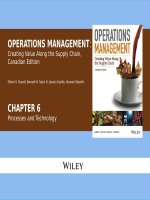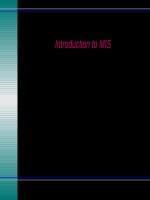Bbi1114 notes 1475227966 chapter 6 prodc
Bạn đang xem bản rút gọn của tài liệu. Xem và tải ngay bản đầy đủ của tài liệu tại đây (1.29 MB, 81 trang )
BECON 1201/ BBI 1113/ BBI 1114 •
Microeconomics
LECTURE 6 PRODUCTION &
COST
Costs & Output Decisions
Faculty of Business Management & Globalization
Tel : 603 8317 8833 (Ext 8407)
Objectives
•
In this chapter, we will focus on the
relationship between a firm’s technology and
its production costs.
BECON 1201/ BBI 1113/ BBI 1114
Students will able to:
1. To describe the production
function.
2. Understand law of
diminishing returns.
3. Understand economies
and diseconomies of scale,
short run & long run.
We will analyze how
factors of production are
combine to produce goods
& services.
Microeconomics
WHAT ARE COSTS?
• According to the Law of Supply:
Supply
– Firms are willing to produce & sell a
greater quantity of a good when the price
is high.
– This results in upward slopping supply
curve.
• The Firm’s Objective
- The economic goal of the firm is to
maximize profits.
BECON 1201/ BBI 1113/ BBI 1114
Microeconomics
DEFINATION OF PRODUCTION
“Production means the process of using the
factors of production to produce G&S.”
“transformation of
inputs into outputs”
Production
inputs things that a firm buys for use in
prod, e.g land, labour, capital &
entrepreneur.
outputs = what we get at the end of the
production/finished products/G&S
produced.
BECON 1201/ BBI 1113/ BBI 1114
Microeconomics
CLASSIFICATION OF F.O.P
1. LAND – natural resources/gift of nature; land
surface, air, lakes, water, minerals, forests etc.
2. LABOUR – physical/mental activities undertaken by
man in exchange for $ reward; lawyer, farmer, PM.
3. CAPITAL – That part of man-made wealth which is
used to further produce wealth; machine, building;
not all $ is capital- sewing machine & shirt
4. ENTERPRENEUR – a person who combines the 3
above, initiates the process of prod & bear the risk.
human ability & talent.
5. TECHNOLOGY – advancements in IT
BECON 1201/ BBI 1113/ BBI 1114
Microeconomics
THE PRODUCTION FUNCTION
“specifies the maximum output that can be produced
from any given amount of inputs”
The prod function shows the technically efficient
ways of combining inputs to produce output.
Relationship between inputs(F.O.P) & outputs (G&S)
In math equation;
Q = f(K,L,M, etc)
Qty of output = f(capital, labour, raw material)
•
•
Means Q depends on f.o.p. f.o.p , Q
Inputs is homogeneous – only qty differ not
quality
BECON
1201/ BBI 1113/ BBI 1114
Microeconomics
Total Revenue, Total Cost, and
Profit
• Total Revenue
– The amount a firm receives for the sale
of its output.
• Total Cost
– The market value of the inputs a firm
uses in production.
BECON 1201/ BBI 1113/ BBI 1114
Microeconomics
Total Revenue, Total Cost, and
Profit
• Profit is the firm’s total revenue minus its total
cost.
Profit = Total revenue - Total cost
Improving Inventory Control at
Wal-Mart
Better inventory controls have
helped reduce firms’ costs.
BECON 1201/ BBI 1113/ BBI 1114
Microeconomics
Costs as Opportunity Costs
• A firm’s cost of production includes all
the opportunity costs of making its
output of goods and services.
• Explicit and Implicit Costs
– A firm’s cost of production include
explicit costs and implicit costs.
• Explicit costs are input costs that require a
direct outlay of money by the firm.
• Implicit costs are input costs that do not
require an outlay of money by the firm.
BECON 1201/ BBI 1113/ BBI 1114
Microeconomics
Economic Profit vs Accounting
Profit
Economists measure a firm’s economic profit as total
revenue minus total cost (TR – TC), including both
explicit and implicit costs.
Accountants measure the accounting profit as the
firm’s total revenue minus only the firm’s explicit
costs.
•
When total revenue exceeds both explicit and
implicit costs, the firm earns economic profit.
Economic profit is smaller than accounting profit.
BECON 1201/ BBI 1113/ BBI 1114
Microeconomics
Figure 1 Economic versus Accountants
How an Economist
Views a Firm
How an Accountant
Views a Firm
Economic
profit
Accounting
profit
Revenue
Implicit
costs
Explicit
costs
BECON 1201/ BBI 1113/ BBI 1114
Revenue
Total
opportunity
costs
Microeconomics
Explicit
costs
Table 1 A Production Function and Total Cost:
Hungry Helen’s Cookie Factory
BECON 1201/ BBI 1113/ BBI 1114
Microeconomics
PRODUCTION AND COSTS
• The Production Function
– The production function shows the
relationship between quantity of inputs
used to make a good and the quantity of
output of that good.
• Marginal Product
– The marginal product of any input in the
production process is the increase in output
that arises from an additional unit of that
input.
BECON 1201/ BBI 1113/ BBI 1114
Microeconomics
Figure 2 Hungry Helen’s Production Function
Quantity of
Output
per hour)
Production function
150
140
130
120
110
100
90
80
70
60
50
40
30
20
10
0
BECON 1201/ BBI 1113/ BBI 1114
1
2
3
4
Microeconomics
Number of Workers Hired
Diminishing Marginal Product
– Diminishing marginal product is the
property whereby the marginal product of
an input declines as the quantity of the
input increases.
–
• Example: As more and more workers are hired
at a firm, each additional worker contributes
less and less to production because the firm
has a limited amount of equipment.
BECON 1201/ BBI 1113/ BBI 1114
Microeconomics
The Marginal Product of Labor and the
Average Product of Labor
The Law of Diminishing Returns
Marginal and Average Product of Labor at Jill Johnson’s Copy Store
QUANTITY OF
WORKERS
QUANTITY OF
COPY
MACHINES
QUANTITY OF
COPIES
MARGINAL
PRODUCT OF
LABOR
0
1
2
3
4
5
6
2
2
2
2
2
2
2
0
625
1,325
2,200
2,600
2,900
3,100
625
700
875
400
300
200
BECON 1201/ BBI 1113/ BBI 1114
Microeconomics
The Marginal Product of Labor and the
Average Product of Labor
Total Output and the
Marginal Product of Labor
Graphing Production
BECON 1201/ BBI 1113/ BBI 1114
Microeconomics
From the Production Function
to the Total-Cost Curve
• The relationship between the quantity
a firm can produce and its costs
determines pricing decisions.
• The total-cost curve shows this
relationship graphically.
BECON 1201/ BBI 1113/ BBI 1114
Microeconomics
Table 1 A Production Function and Total
Cost: Hungry Helen’s Cookie Factory
BECON 1201/ BBI 1113/ BBI 1114
Microeconomics
Figure 3 Hungry Helen’s Total-Cost Curve
Total
Total-cost
curve
$80
70
60
50
40
30
20
10
0
10 20 30 40 50 60 70
BECON 1201/ BBI 1113/ BBI 1114
80 90 100 110 120 130 140 150
Microeconomics
of Output
(cookies per hour)
THE VARIOUS MEASURES OF COST
Costs of production may be divided into
fixed costs and variable costs.
Fixed and Variable Costs
Fixed costs are those costs that do not
vary with the quantity of output produced.
(rent)
Variable costs are those costs that do
vary with the quantity of output produced.
BECON 1201/ BBI 1113/ BBI 1114
Microeconomics
Fixed and Variable Costs
• Total Costs
– Total Fixed Costs
(TFC)
– Total Variable Costs (TVC)
– Total Costs
(TC)
TC = TFC + TVC
BECON 1201/ BBI 1113/ BBI 1114
Microeconomics
The salaries of editors
are considered a fixed
cost by publishers.
Table 2 The Various Measures of Cost: Thirsty
Thelma’s Lemonade Stand
BECON 1201/ BBI 1113/ BBI 1114
Microeconomics
• Average Costs
– Average costs can be determined by dividing
the firm’s costs by the quantity of output it
produces. (TC/Qty)
– The average cost is the cost of each typical unit
of product.
Average Costs
Average Fixed Costs
(AFC)
Average Variable Costs (AVC)
Average Total Costs
(ATC)
BECON 1201/ BBI 1113/ BBI 1114
ATC = AFC
+ AVC
Microeconomics
Average Costs
F ix e d c o s t
F C
A F C
Q u a n tity
Q
V a ria b le c o s t
V C
A V C
Q u a n tity
Q
T o ta l c o s t
T C
A T C
Q u a n tity
Q
BECON 1201/ BBI 1113/ BBI 1114
Microeconomics









